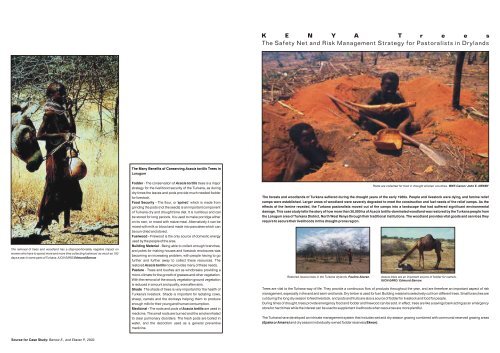Forest landscape restoration in East Africa - Tanzania Development ...
Forest landscape restoration in East Africa - Tanzania Development ...
Forest landscape restoration in East Africa - Tanzania Development ...
Create successful ePaper yourself
Turn your PDF publications into a flip-book with our unique Google optimized e-Paper software.
K E N Y A T r e e sThe Safety Net and Risk Management Strategy for Pastoralists <strong>in</strong> DrylandsThe Many Benefits of Conserv<strong>in</strong>g Acacia tortilis Trees <strong>in</strong>LorugumThe removal of trees and woodland has a disproportionately negative impact onwomen who have to spend more and more time collect<strong>in</strong>g fuelwood as much as 100days a year <strong>in</strong> some parts of Turkana. IUCN-EARO/ Edmund BarrowFodder - The conservation of Acacia tortilis trees is a majorstrategy for the livelihood security of the Turkana, as dur<strong>in</strong>gdry times the leaves and pods provide much needed fodderfor livestock.Food Security - The flour, or 'ap<strong>in</strong>et,' which is made fromgr<strong>in</strong>d<strong>in</strong>g the pods (not the seeds) is an important componentof Turkana dry and drought time diet. It is nutritious and canbe stored for long periods. It is used to make porridge eitheron its own, or mixed with maize meal. Alternatively it can bemixed with milk or blood and made <strong>in</strong>to pancakes which canbe sun-dried and stored.Fuelwood - Firewood is the only source of domestic energyused by the people of the area.Build<strong>in</strong>g Material - Be<strong>in</strong>g able to collect enough branches,and poles for mak<strong>in</strong>g houses and livestock enclosures wasbecom<strong>in</strong>g an <strong>in</strong>creas<strong>in</strong>g problem, with people hav<strong>in</strong>g to gofurther and further away to collect these resources. Therestored Acacia tortilis now provides many of these needs.Pasture - Trees and bushes act as w<strong>in</strong>dbreaks provid<strong>in</strong>g amicro-climate for the growth of grasses and other vegetation.With the removal of the woody vegetation ground vegetationis reduced <strong>in</strong> amount and quality, even after ra<strong>in</strong>s.Shade The shade of trees is very important for the health ofTurkana's livestock. Shade is important for lactat<strong>in</strong>g cows,sheep, camels and the donkeys help<strong>in</strong>g them to produceenough milk for their young and human consumption.Medic<strong>in</strong>al - The roots and pods of Acacia tortilis are used <strong>in</strong>medic<strong>in</strong>e. The small roots are burned and the smoke <strong>in</strong>haledto clear pulmonary disorders. The fresh pods are boiled <strong>in</strong>water, and the decoction used as a general preventivemedic<strong>in</strong>e.Roots are collected for food <strong>in</strong> drought stricken countries. WWF-Canon/ John E. NEWBYThe forests and woodlands of Turkana suffered dur<strong>in</strong>g the drought years of the early 1960s. People and livestock were dy<strong>in</strong>g, and fam<strong>in</strong>e reliefcamps were established. Larger areas of woodland were severely degraded to meet the construction and fuel needs of the relief camps. As theeffects of the fam<strong>in</strong>e receded, the Turkana pastoralists moved out of the camps <strong>in</strong>to a <strong>landscape</strong> that had suffered significant environmentaldamage. This case study tells the story of how more than 30,000 ha of Acacia tortilis-dom<strong>in</strong>ated woodland was restored by the Turkana people fromthe Lorugum area of Turkana District, North West Kenya through their traditional <strong>in</strong>stitutions. The woodland provides vital goods and services theyrequire to secure their livelihoods <strong>in</strong> this drought-prone region.Restored Acacia trees <strong>in</strong> the Turkana drylands. Paul<strong>in</strong>e Akaran.Acacia trees are an important source of fodder for camels.IUCN-EARO/ Edmund Barrow.Trees are vital to the Turkana way of life. They provide a cont<strong>in</strong>uous flow of products throughout the year, and are therefore an important aspect of riskmanagement, especially <strong>in</strong> the arid and semi-arid lands. Dry timber is used for fuel. Build<strong>in</strong>g material is selectively cut from different trees. Small branches arecut dur<strong>in</strong>g the long dry season to feed livestock, and pods and fruits are also a source of fodder for livestock and food for people.Dur<strong>in</strong>g times of drought, trees provide emergency food and fodder and firewood can be sold. In effect, trees are like a sav<strong>in</strong>gs bank act<strong>in</strong>g as an emergencystore for hard times while the <strong>in</strong>terest can be used to supplement livelihoods when resources are more plentiful.The Turkana have developed an <strong>in</strong>tricate management system that <strong>in</strong>cludes wet and dry season graz<strong>in</strong>g comb<strong>in</strong>ed with communal reserved graz<strong>in</strong>g areas(Epaka or Amaire) and dry season <strong>in</strong>dividually-owned fodder reserves (Ekwar).Source for Case Study: Barrow E., and Ekaran P., 2002.
















